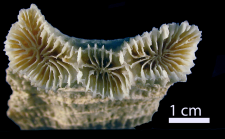
| Intro | | About | | Wiki | | Search traits | | Data explorer | | Literature | | Definitions | | Sources | | Webservices | | Statistics | | Feedback | | Editors | | Log in |
WoRMS name detailsErythrastrea Pichon, Scheer & Pillai, 1983
204891 (urn:lsid:marinespecies.org:taxname:204891)
unaccepted > junior subjective synonym
Genus
Erythrastrea flabellata Pichon, Scheer & Pillai, 1983 accepted as Oulophyllia wellsi (Ma, 1959) (type by original designation)
marine,
recent + fossil
Scheer, G. & Pillai, C.S.G. 1983. Report on the stony corals from the Red Sea. Zoologica, Stuttgart 45 (133): 1-198, pls. 1-41. [details]
Description 'Phaceloid, branches flabellate, compressed, epithecate. Wall thin. Calices meandering, valleys short or long and sinuous,...
Description 'Phaceloid, branches flabellate, compressed, epithecate. Wall thin. Calices meandering, valleys short or long and sinuous, 5 to 10 mm wide, 4 to 5 mm deep. Columella centres distinct, formed of septal fusion, adjacent ones linked by indistinct lamellae. Septa exsert vertically, edges dentate. Costae very conspicuous, extend to the base of the flabellate branches, often linked by transverse ridges.' (Scheer and Pillai, 1983: 104) [details] Description Colonies are flabello-meandroid with thin walls and distinct columellae (Veron, 1986 <57>).
Description Colonies are flabello-meandroid with thin walls and distinct columellae (Veron, 1986 <57>). [details]
Hoeksema, B. W.; Cairns, S. (2024). World List of Scleractinia. Erythrastrea Pichon, Scheer & Pillai, 1983. Accessed through: World Register of Marine Species at: https://www.marinespecies.org/aphia.php?p=taxdetails&id=204891 on 2024-12-22
Date action by 1998-06-04 11:18:58Z changed Depew, Lorna
original description
Scheer, G. & Pillai, C.S.G. 1983. Report on the stony corals from the Red Sea. Zoologica, Stuttgart 45 (133): 1-198, pls. 1-41. [details]
context source (Hexacorallia) Fautin, Daphne G. (2013). Hexacorallians of the World. (look up in IMIS) [details] additional source Khalil HM, Fathy MS, Al Sawy SM. (2021). Quaternary corals (Scleractinia: Merulinidae) from the Egyptian and Saudi Arabian Red Sea Coast. <em>Geological Journal.</em> , available online at https://onlinelibrary.wiley.com/doi/10.1002/gj.4145?af=R [details] additional source Veron JEN. (1986). Corals of Australia and the Indo-Pacific. <em>Angus & Robertson Publishers.</em> [details] additional source Veron JEN. (2000). Corals of the World. Vol. 1–3. <em>Australian Institute of Marine Science and CRR, Queensland, Australia.</em> [details] additional source Budd AF, Fukami H, Smith ND, Knowlton N. (2012). Taxonomic classification of the reef coral family Mussidae (Cnidaria: Anthozoa: Scleractinia). <em>Zoological Journal of the Linnean Society.</em> 166 (3): 465-529., available online at https://doi.org/10.1111/j.1096-3642.2012.00855.x [details] additional source Huang D, Benzoni F, Fukami H, Knowlton N, Smith ND, Budd AF (2014) Taxonomic classification of the reef coral families Merulinidae, Montastraeidae, and Diploastraeidae (Cnidaria: Anthozoa: Scleractinia). Zoological Journal of the Linnean Society 171: 277–355. [details] source of synonymy Arrigoni R, Huang D, Berumen ML, Budd AF, Montano S, Richards ZT, Terraneo TI, Benzoni F. (2021). Integrative systematics of the scleractinian coral genera Caulastraea, Erythrastrea and Oulophyllia. <em>Zoologica Scripta.</em> 50(4): 509-527., available online at https://onlinelibrary.wiley.com/doi/abs/10.1111/zsc.12481 [details]  Present Present  Inaccurate Inaccurate  Introduced: alien Introduced: alien  Containing type locality Containing type locality
From editor or global species database
Comparison Erythrastrea has never been collected for molecular work or subcorallite morphology, and only macromorphological characters has been examined. Veron, 1986: 595 described the genus as similar to Caulastraea based on 'skeletal structures', and is also like Trachyphyllia (and Nemenzophyllia) because of the flabello-meandroid colony form. Based on the holotype, we diagnosed Erythrastrea as matching in all but one character each with Caulastraea (discrete instead of uniserial) and Oulophyllia (fused walls instead of phaceloid), suggesting possible placement of the genus within subclade XVII-D/E (Caulastraea + Oulophyllia + Pectinia + Mycedium). It does not have the strong septal (multiaxial) lobes seen in Trachyphyllia, and their internal lobes are even weaker than in Caulastraea and Oulophyllia. A fine epitheca may be present—unlike in the latter genera—but the thin walls and phaceloid form are indicative of its close affinity to Caulastraea, as interpreted by Scheer and Pillai, 1983: 104. [details]Description 'Phaceloid, branches flabellate, compressed, epithecate. Wall thin. Calices meandering, valleys short or long and sinuous, 5 to 10 mm wide, 4 to 5 mm deep. Columella centres distinct, formed of septal fusion, adjacent ones linked by indistinct lamellae. Septa exsert vertically, edges dentate. Costae very conspicuous, extend to the base of the flabellate branches, often linked by transverse ridges.' (Scheer and Pillai, 1983: 104) [details] Diagnosis Colonial, with intracalicular budding only. Corallites monomorphic and uniserial; monticules absent. Phaceloid. Calice width medium (4–15 mm), with medium relief (3–6 mm). Septa in 3 cycles (24–36 septa). Free septa present but irregular. Septa spaced < 6 septa per 5 mm. Costosepta equal in relative thickness. Columellae trabecular and spongy (> 3 threads), < 1/4 of calice width, and continuous among adjacent corallites. Paliform (uniaxial) and septal (multiaxial) lobes may be present but weak. Epitheca reduced or absent and endotheca abundant (vesicular). [details] Remark Erythrastrea Scheer and Pillai, 1983: 104 is a monotypic genus that is known only from the Red Sea. In the original description of its species titled 'Erythrastrea flabellata Pichon, Scheer and Pillai, in press', the authors list as paratypes USNM Wa 75a, b collected from Ghardaqa, Egypt, and NS 6062, 6063 from Tel Aviv, Israel, without any mention of a holotype. Cairns, 1991: 33 explains that the paper cited was never published, stating that 'Both the generic and species descriptions of Scheer and Pillai (1983) satisfy the requirements of the Code and therefore should be considered as the original descriptions.' Furthermore, Cairns (1991) lists USNM 78094 as a 'paratype', in accordance with the original description. [details] Unreviewed
Description Colonies are flabello-meandroid with thin walls and distinct columellae (Veron, 1986 <57>). [details]
|
